Aberdeen can easily accommodate that traffic volume with one lane in each direction and a centre turn lane. That gives us some room to play.
By Ryan McGreal
Published October 30, 2015
A few weeks ago, I wrote about the potential to put Aberdeen Avenue on a road diet and the arguments against doing this that were raised by Ward 8 Councillor Terry Whitehead, whose residents use Aberdeen as a cut-through route to Highway 403 and West Hamilton.
Aberdeen is a designated minor arterial street that connects the Beckett Drive escarpment access at Queen Street South to Longwood Road South and Highway 403, passing Locke Street South and Dundurn Street South along the way.
It is four lanes wide but carries only 18,000 vehicles a day. With two lanes in each direction, drivers are able to pass each other at dangerously high speeds just inches away from the narrow sidewalks.
The street can easily accommodate that traffic volume with one lane in each direction and a centre turn lane. (For comparison, the Beckett Drive escarpment access currently carries over 20,000 vehicles a day on just two lanes.)
That means we can free up a lane to make Aberdeen a more complete street while still allowing it to function as a minor arterial for cut-through traffic, albeit at safer speeds.
Another way to reduce dangerous speeding and free up space is to narrow the lanes, which are currently 3.2 - 3.3 metres wide. A growing body of evidence concludes that narrower lanes are actually safer than wide lanes, mainly because they reduce dangerous speeding.
According to City Traffic staff, Aberdeen is 13 metres wide, curb to curb. If we add in the narrow 1.5 metre sidewalks, that gives us a total right-of-way of 16 metres.
At last night's Kirkendall Neighbourhood Assocation Annual General Meeting, Ward 1 Councillor Aidan Johnson said it is unlikely we will be able to achieve wider sidewalks, so we will have to have to look at other options for making the street safer.
Using the Streetmix street design tool, we can play around with that space to come up with some alternate designs that are safer and more inclusive than the current arrangement.
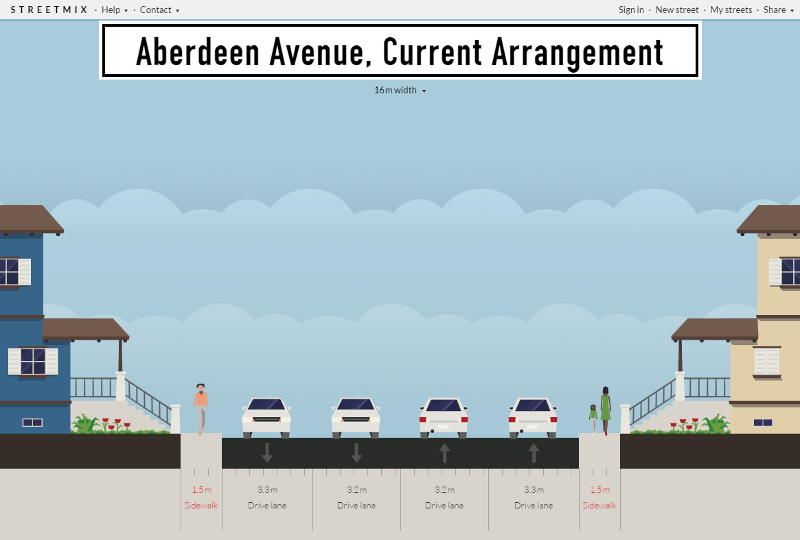
Streetmix: Aberdeen Avenue, current arrangement
Right off the bat, we can look to other similar streets in Hamilton for ideas. One street that comes to mind is Lawrence Road, which is also a minor arterial and also connects to a highway - the Red Hill Valley Parkway.
Lawrence Road is one lane in each direction with a centre turn lane and painted bike lanes.
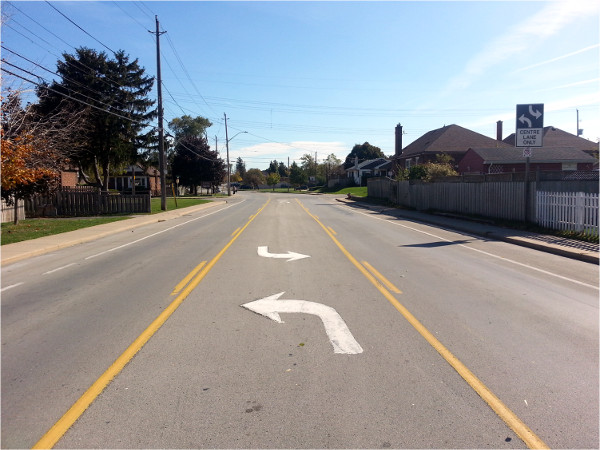
Lawrence Road
Here's how that design could fit on Aberdeen:
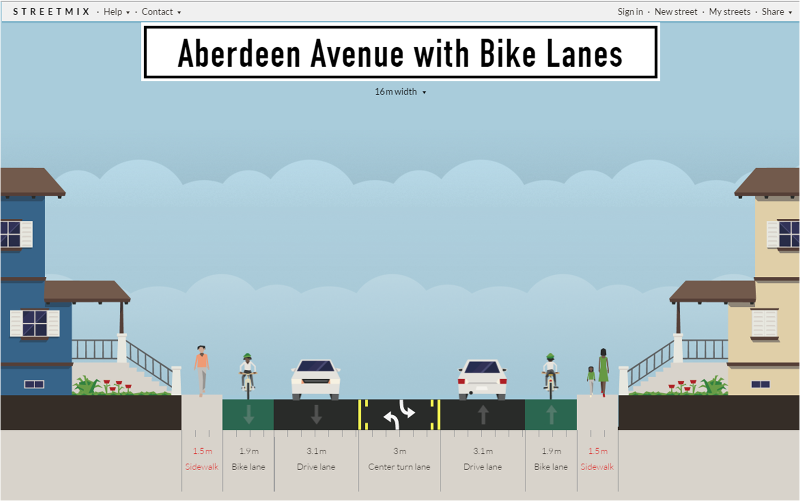
Streetmix: Aberdeen Avenue with bike lanes
This has the added advantage of using the bike lanes as a buffer to protect people on the sidewalks from vehicles. A bicycle passing close by is a lot less dangerous and intimidating than a passing vehicle.
This arrangement is definitely an improvement on the status quo, but if we're going to redesign the street we should aim for the best design possible, not simply settle with "better enough".
We know the most effective design for attracting more people to choose a bike for some trips is to provide physically protected cycling routes. That should be the goal for every new piece of cycling infrastructure, especially on a thoroughfare.
We have room on Aberdeen for a wide, high-quality protected cycle track while still allowing a vehicle lane in each direction with a centre turn lane.
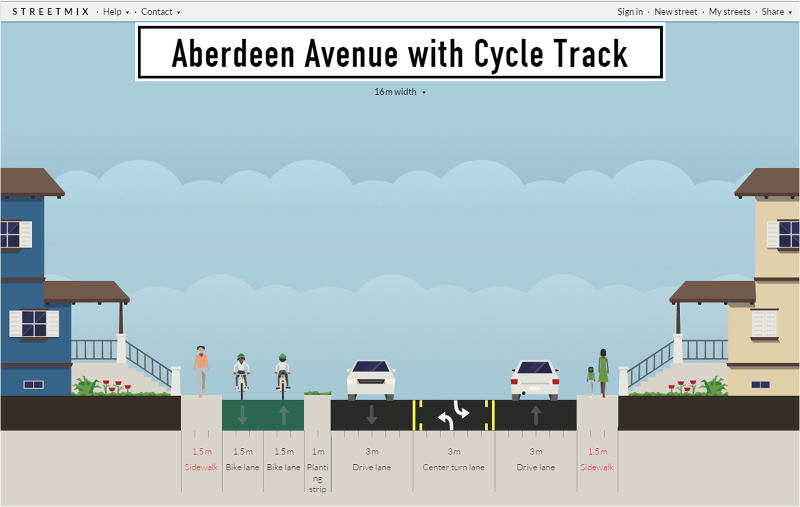
Streetmix: Aberdeen Avenue with protected cycle track
Now we're talking!
But some residents and local stakeholders will also want curbside parking, especially around Dundurn where there are local businesses. So that becomes another demand on the street's right-of-way. Let's start with the most basic design that accommodates curbside parking:
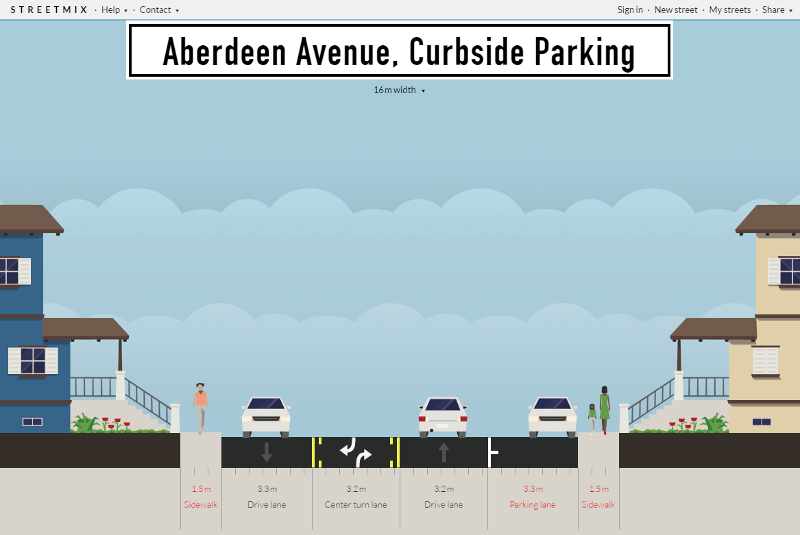
Streetmix: Aberdeen Avenue with curbside parking on north side
Again, that's an improvement on the status quo but misses the chance to be excellent. We can make better use of some of that road space by rejigging those lane widths to add in a bike lane on the south side and a wide sharrow lane on the north side:
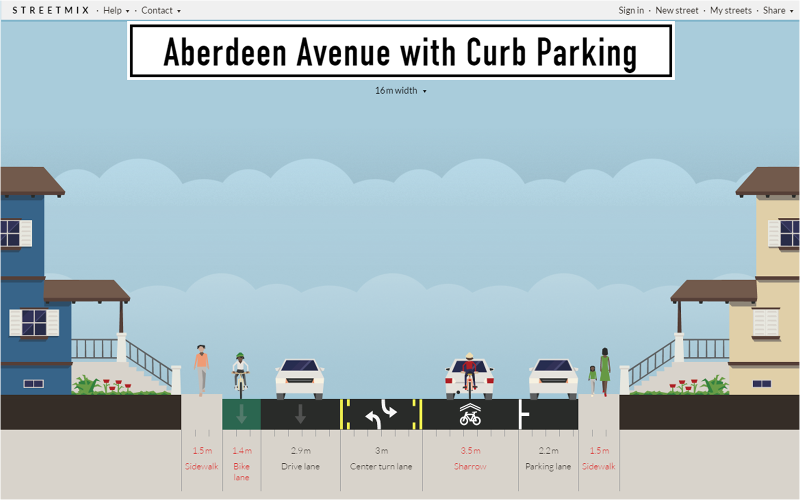
Streetmix: Aberdeen Avenue with curbside parking, bike lane and sharrow lane
This is pretty low-quality cycling infrastructure. The sharrow lane, in particular, will not be able to entice many people to hop on a bike and ride in mixed cut-through traffic.
If we squeeze the lanes some more we can get dedicated painted bike lanes in both directions:
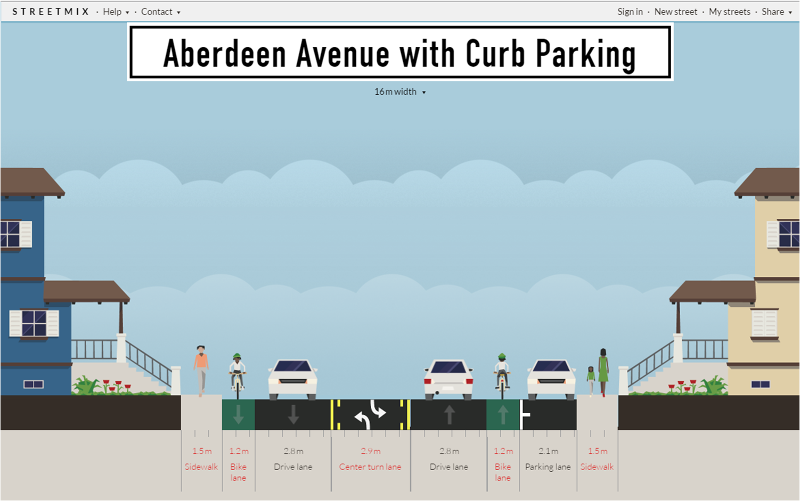
Streetmix: Aberdeen Avenue with curb parking and bike lanes
The problem now is that the bike lane on the north side is running right in the "door zone" of those parked cars. That's actually quite a dangerous design: if a person in one of those parked cars throws open their door without checking for an approaching person on a bike, that cyclist will have to either crash into the door or veer out into the vehicle lane. Yikes!
But we have some more options to make this safer. One thing we can do is put the bike lane on the other side of the parallel parked cars:
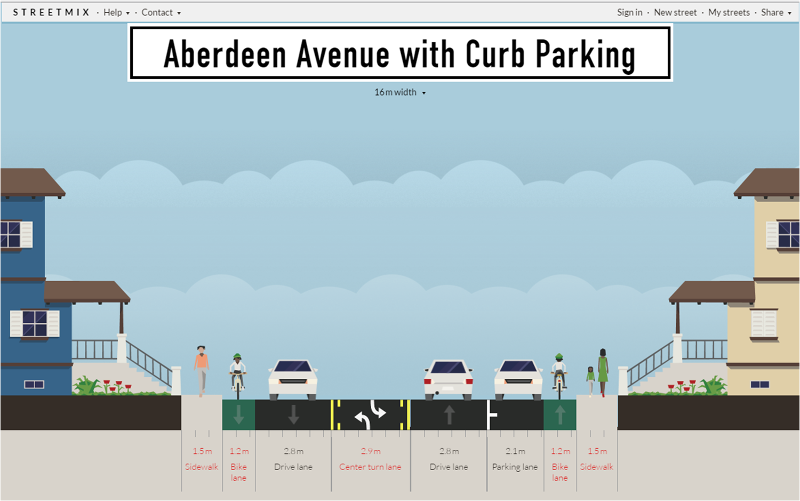
Streetmix: Aberdeen Avenue with bike lane and curb parking protected bike lane
New York City has had great success with parking-protected bike lanes. They have proven to be safer and better at attracting new cyclists than unprotected painted lanes. The bike lane is still in the "door zone", but it's the passenger side so there will be a lot fewer doors opening.
But if we're putting bike lanes behind parked cars, why not protect both bike lanes?
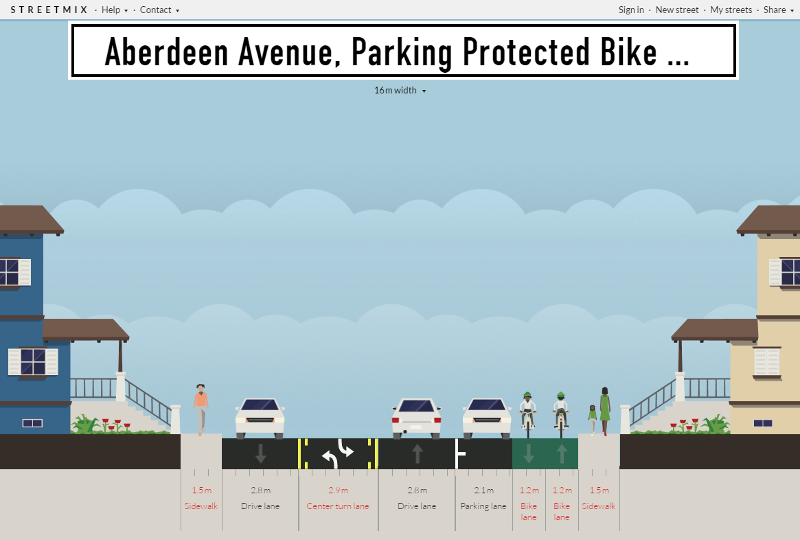
Streetmix: Aberdeen Avenue with curb parking protected cycle track
Now we're really talking. This improves further on the "door zone" issue, because the bicycles in the passenger door zone are approaching from the front, which means a passenger will naturally be looking in the direction of any approaching bicycle traffic. Also, if a person on a bicycle does hit a door, the door will swing closed instead of being locked open.
Finally, the cyclist will be able to see if there is any approaching bicycle traffic in the oncoming bike lane instead of having to veer out blindly into a driving lane where approaching traffic is coming from behind.
I'm sure the Public Works Department will object to the narrow lane widths, but we have clear evidence that narrow lanes are actually safer than wide lanes.
We will also hear about how challenging it will be to clear snow in the parking-protected cycle track, but other cities seem to have no problem doing it. And in any case, most of Hamilton's bike lanes aren't cleared of snow anyway.
I'm not saying this has to be the final design we use on Aberdeen. My point is that we have lots of options to make the street safer, more inclusive and more humane for people living on and around it, while still accommodating the street's role as a minor arterial for cut-through traffic.
By AP (registered) | Posted October 30, 2015 at 07:58:14
Love that you have offered each progressively better option; if a suboptimal design is proposed, we will be quickly able to identify the shortcomings and understand what could be done to make it better.
By JasonL (registered) | Posted October 30, 2015 at 08:38:22
Great piece. I'm glad Kirkendall has a solid neighbourhood association. As we've seen with the recent Cannon bike lane extension, Hunter bike lanes, and Herkimer/Charlton plans, you certainly WILL have the most basic, least useful design suggested from city hall and will need to counter it with these better options that have become commonplace in cities around the world, including our closest city up the QEW. Toronto has started to do a very impressive job at making up for lost time with protected bike lanes through it's downtown core.
Of course, Hamilton squelchers will point out that it could never work here because unlike downtown TO, we have serious traffic issues and can't sacrifice road space.
But keep up the good advocacy, and hope for similar results to Charlton/Herkimer.
By JasonL (registered) | Posted October 30, 2015 at 08:43:27
By way of coincidence, I open twitter today to yet another protected bike lane installation in Toronto overnight:
https://twitter.com/TO_Cycling/status/66...
Funny how it doesn't take them multiple years to do such simple projects. Yes, Herkimer/Charlton/Hunter I'm looking at you. Embarrassing.
By Crispy (registered) | Posted October 30, 2015 at 08:51:39
Public works department has no say in it: they are puppets. Councillors always have the final say and are driven by the end goal of re-election.
By Stephen Barath (anonymous) | Posted October 30, 2015 at 12:40:50
Walking next to bicycle lanes or street parking would be a huge improvement over walking directly adjacent to very fast live traffic, but I'm curious why sidewalks wider than 1500 millimetres (less than five feet) would be dismissed so quickly. There's some commercial on this street, and a lot of foot traffic will always be generated by Westdale High and MIP...so why would anything more than the absolute bare minimum sidewalk width be impossible?
By Pxtl (registered) - website | Posted October 30, 2015 at 12:54:29 in reply to Comment 114486
All of Ryan's recommended plans require some paint and possibly some modifications to traffic signals. No new concrete. Even the "protected" bike lanes are protected by parked cars and not curbs or knock-down-sticks.
Wider sidewalks would require new concrete, which raises the cost of this modification by an order of magnitude.
By Stephen Barath (anonymous) | Posted October 30, 2015 at 13:20:13 in reply to Comment 114489
Thanks. I didn't realize that one of the criteria was that it has to be practically free, but that makes sense.
Again, putting anything alongside the sidewalk that isn't a live lane of fast-moving traffic is a marked improvement. It's a shame we're not able to spring for sidewalks wide enough that (say) someone in a wheelchair and someone pushing a stroller could pass each other.
By Michelle Martin (registered) - website | Posted October 31, 2015 at 14:24:27 in reply to Comment 114495
Hear, hear!
By GrapeApe (registered) | Posted October 30, 2015 at 12:42:37
I agree but to add a few thoughts:
final sketch still leaves narrow sidewalk against traffic, for that reason 2nd last sketch appeals to me more.
a truly complete street (imho) needs consideration for signage/obstruction placement policy. The narrow sidewalks are hard enough for able bodied, but virtually impassable for those in wheelchairs. Signs, parking payment, driveway slopes, etc. steal already limited space.
By mdrejhon (registered) - website | Posted October 30, 2015 at 12:58:23
Bidirectional center turn lanes are notoriously wide in Hamilton.
They tend to be over 10 feet wide (>3m wide).
On the newly painted Cannon bike lanes painted past Gage Park, the bike lanes narrow from ~55" to only ~47" to accomodate a 125" wide center turning lane that really don't need to be that wide.
Even 2.9 meter is still wider than a non-bidrectional turning lane on Barton Ave. Can't Public Works narrow center turning lanes a smidgen? It would result in fewer total deaths. (cars+bikes+pedestrians)
Comment edited by mdrejhon on 2015-10-30 12:59:47
By splashed (anonymous) | Posted October 30, 2015 at 14:02:03
you would of got splashed that time even if cars were going like 40 k or lower.when R rth was a boy, problem was horse poo on the road, so now its water
By Simmons (registered) | Posted October 30, 2015 at 16:27:07
In these situations, is any consideration given to transit? The Aberdeen 6 bus travels semi-frequently on this road meaning there will be minor delays during those periods. I'm just curious what other municipalities do or what would be most effective to keep everyone moving at a reasonable pace. Part of me thinks cars will dangerously and frustratingly use the centre lane to get around buses.
By Pxtl (registered) - website | Posted October 30, 2015 at 16:51:17 in reply to Comment 114504
The Universtiy buses in Westdale dwarf the Aberdeen 6 in popularity, and there's a popular stop at King and Bond in which the westbound bus pulls over into a bike-lane, leaving only half a car lane for drivers. Drivers go around the bus and push a bit into oncoming traffic.
Nobody has been horribly killed in a fiery wreck yet, so it seems to indicate that people can handle slowing down and being careful around a stopped obstruction like a bus. And I think you'll agree that an oncoming is much more serious than a turning lane for getting around a bus.
That's definitely a point in favour of Ryan's penultimate "Aberdeen Avenue with bike lane and curb parking protected bike lane" option.
By mdrejhon (registered) - website | Posted October 31, 2015 at 02:07:32
1.2 meter bike lanes are way too narrow by themselves but a 2.4-meter-wide cycle track is perfectly fine -- that's nearly exactly how wide the Cannon cycle track is.
By KevinLove (registered) | Posted November 01, 2015 at 00:08:55
Here is an example of a better quality of bidirectional cycle lanes.. Note the physical protection on a street about the same width as Aberdeen.
By logonfire (registered) | Posted November 01, 2015 at 11:53:52
My question is: Why design bike lanes into the arterial streets in the first place? It would MUCH be safer to use the parallel streets (in this case Homewood and Stanley from Queen St. westward. Cyclists would be MUCH safer in bike lanes along these roads!
By moylek (registered) - website | Posted November 01, 2015 at 12:03:03 in reply to Comment 114538
Why design bike lanes into the arterial streets in the first place?
I want to use an arterial street when going places on my bike for the same reason I want to drive on them when going places in my truck: it's a direct route to where I want to go; many of the destinations on such streets; I don't have to encounter a stop sign every block.
Comment edited by moylek on 2015-11-01 13:03:18
By Pxtl (registered) - website | Posted November 01, 2015 at 12:34:29 in reply to Comment 114539
Not just that, but none of the alternatives connect to Longwood anyways. So you have to put a bike lane for the dundurn->Longwood span, you may as well continue that right to Queen.
By Terrance56 (anonymous) | Posted November 02, 2015 at 10:57:02
I was at the Kirkendall Neighbourhood Meeting the other night and listened to a fantastic proposal about this very topic.I am of the mind as Ryan said that if the residents of Cannon street took hold of their street with " Yes we Cannon " then as Ryan says perhaps we need to start a committee and take back our street and call it " Aberdone" because we as the residents of this street are going to get it done, not because of the city but in spite of the city. It is time to step up and take our street back to a day when it was quieter and safer. This can be done together it can be
" Aberdone"
By mdrejhon (registered) - website | Posted November 03, 2015 at 15:05:25 in reply to Comment 114557
Go for it!
There's a free weekend community/civic engagement course to learn about starting such a group. I believe it is run by Hamilton Community Foundation and the next course starts in January. This might be right up your alley and give you important connections. I picked up a flyer at last night's Sherman Hub meeting.
Comment edited by mdrejhon on 2015-11-03 16:08:12
You must be logged in to comment.
There are no upcoming events right now.
Why not post one?